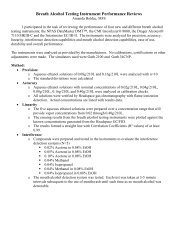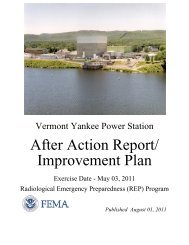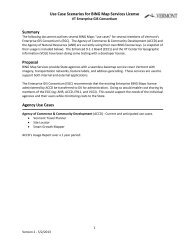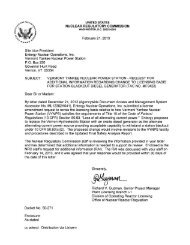3-1-2013 Letter from VY to NRC Plan for Reliable ... - State of Vermont
3-1-2013 Letter from VY to NRC Plan for Reliable ... - State of Vermont
3-1-2013 Letter from VY to NRC Plan for Reliable ... - State of Vermont
- No tags were found...
Create successful ePaper yourself
Turn your PDF publications into a flip-book with our unique Google optimized e-Paper software.
AREVA NP Inc. ANP-3203Revision 0<strong>Vermont</strong> Yankee Nuclear Power Station’s Overall Integrated <strong>Plan</strong> in Response <strong>to</strong> March 12, 2012Commission Order Modifying Licenses with Regard <strong>to</strong> Requirements <strong>for</strong> <strong>Reliable</strong> HardenedContainment Vents (Order Number EA-12-050)Page 16design. analyses. operating experience, and/or testing <strong>of</strong> channel components foi the following sets <strong>of</strong>parametersaradiological conditions that the instruments may encounter under normal plant conditions, and duringand after a prolonged SBO event.• temperatures and pressure conditions as doscnbed under requirementloading <strong>from</strong> system operation.128.including dynamic• humidity based on instrument location and effluent conditionsResponse (ref. ISG Item 1.2.4):inthe HCVS.The design <strong>of</strong> the HCVS will have temperature and pressure moni<strong>to</strong>ring downstream <strong>of</strong> the lastcontainment isolation valve. All flow path valves will have open and closed position indication.These HCVS indications will be at or near the same location as the valve control switches,which is the MCR and remote control station. Motive air/gas pressure and power sourcevoltage will be moni<strong>to</strong>red (voltage <strong>for</strong> the 125 VOC station batteries can be moni<strong>to</strong>red <strong>from</strong> theDC panels located in the cable spreading room).Power <strong>for</strong> the instrumentation <strong>for</strong> the remote control station will be <strong>from</strong> the safety related B-AS2 battery, its chargers and switchgear are located in the adjacent Diesel Genera<strong>to</strong>r room.Power <strong>from</strong> essential DC batteries will be used <strong>to</strong> supply the SOVs used <strong>to</strong> position the AOVs.Refer <strong>to</strong> the response <strong>to</strong> 1.2.2 <strong>for</strong> discussion on the power.The approximate range <strong>for</strong> the temperature indication will be 50°F <strong>to</strong> 600°F. The approximaterange <strong>for</strong> the pressure indication will be 0 psig <strong>to</strong> 120 psig. The upper limits are approximatelytwice the required design containment temperature and pressure. The ranges will be finalizedwhen the detailed design and equipment specifications are prepared.The detailed design will address the radiological, temperature, pressure, flow induced vibration(if applicable) and internal piping dynamic <strong>for</strong>ces, humidity/condensation and seismicqualification requirements. Assumed radiological conditions are those expected after aprolonged SBO (without fuel failure), which will bound normal plant conditions.Requirement 1.2.5- Moni<strong>to</strong>rthe Effluent Discharge <strong>for</strong> RadioactivityThe HCVS shall include a means<strong>from</strong> operation <strong>of</strong> the HCVS The moni<strong>to</strong>ring system shall provide indication<strong>to</strong> moni<strong>to</strong>r the effluent discharge <strong>for</strong> radioactiwty that may be releasedinlocation(s), and shall be designed <strong>for</strong> sustained operation during a prolonged SBO.ISG 12.5 Criteria:the control room or otherLicensees shall provide an independent means <strong>to</strong> moni<strong>to</strong>r overall radioactivity that may be released <strong>from</strong> theHCVS discharge The radiation moni<strong>to</strong>r does not need <strong>to</strong> meet the requirements <strong>of</strong> NUREG 0737 <strong>for</strong>moni<strong>to</strong>red releases, nor does it need <strong>to</strong> be able moni<strong>to</strong>r releases quantitatively <strong>to</strong> ensure compliance withTitle10 <strong>of</strong> the Code <strong>of</strong> Federal Regulations (10 CFR) Pa#1(A) or 10 CFR Section. 67A wide-rangemoni<strong>to</strong>ring system <strong>to</strong> moni<strong>to</strong>r the overall activity in the release providing indication that effluent <strong>from</strong> thecontainment environment that is passing by the moni<strong>to</strong>r is acceptable The use <strong>of</strong> other existing radiationmoni<strong>to</strong>ring capabilityinlieu <strong>of</strong> an independent HCVS radiation moni<strong>to</strong>r is not acceptable because plan<strong>to</strong>pera<strong>to</strong>rs need accurate in<strong>for</strong>mation about releases coming <strong>from</strong> the containment via the HCVS in order <strong>to</strong>make in<strong>for</strong>med decisions on operation <strong>of</strong> the reliable hardened venting system






